Introduction
This is an in-depth review of the Ooni Volt 12 oven. It includes both my initial impressions and an update after 7 months of using making pizza with it. I start with why I ordered the Volt 12 and what I initially thought of it, then I provide an updated review based on several months spent making pizza with the oven. If you want, you can click to jump straight to my thoughts after 7 months but if you’re early in the decision making process, I’d start from the beginning.
To provide a quick summary, I really like the Ooni Volt and would buy it again if given the choice. To me the best thing about the Volt is that it makes making pizza easier (more on that in my throughout the review). However, the only place the Volt 12 really outshines your standard home oven is for making Neapolitan-style pizzas (click to jump to the relevant section). I’ve also experienced some intense and concerning condensation on the interior of the oven, details and photos in the Concerning Condensation section. And, while the oven makes excellent pizzas indoos, you’ll have an easier time if you use it outdoors, as I explain in the linked section. So, if you’re considering the Volt, I recommend reading (or at least skimming) this review before deciding. It’s a great oven but not necessarily for everyone.
(Ooni provided no discounts, compensation, or incentives for my review — see my Disclosures for additional details.)
Initial Impressions of the Volt 12
I started looking for a dedicated pizza oven towards the end of 2022. While I enjoy the challenge and ingenuity required to duplicate Neapolitan-style pizza recipes in your home oven, I wanted to experience high-temperature cooking. For a while, I had my heart set on either a gas or wood powered oven, but after thinking it through more and discussing with a more experienced pizza maker, I realized electric made more sense for me. First, I don’t have a good outdoor space for a wood or gas oven. Second, I’m busy and finding time to manage a fire, purchase propane or wood, and so on, seemed enough to potentially derail my efforts before they started.
When I started my search, the Breville Pizzaiolo was the only readily available high-heat electric option,* and I was about to purchase one. But, then I actually saw it in person and came away surprised by the amount of plastic it contained. That and the fact it only hit 750° F, led me to hold off, hoping for something better. I’m glad I did because a few months later, in March 2023, Ooni released the Volt 12. An oven with a larger cooking surface and a max temperature of 850° F, 100° F hotter than the Breville. Based on my experience with the Volt, I think that 100 degrees will make a significant differences in your results.
*As an aside, Effeuno does offer an oven that claims to get even hotter than the Volt 12. I found one dealer that appears to sell in the U.S., but I opted against the Effeuno due to the higher cost and my concerns with its voltage requirements of 220v – 240v, significantly more than the standard 120v most U.S. outlets emit. It may be possible to convert, but, from my limited research, it sounds like converters may not work with higher watt appliances.
I ordered my Volt 12 not long after it came out, choosing Crate & Barrel because they offered a 10% discount, which no other retailer had at the time. I had to wait a few weeks for delivery. When the Fedex delivery person dropped off my new oven, I thought, “wow, this is huge!” Of course, the oven itself turned out to be much smaller than the packaging that surrounds it, but it remains by far the largest countertop oven I’ve seen. Size aside, I love how Ooni designed the Volt 12. It’s well made, with less visible plastic than the Breville. (It’s certainly not plastic free and at peak temp, I notice a faint plastic aroma when close to the oven.)
The Volt 12 Is Easy to Use and Set Up
To start, the Volt 12 met my desire for an oven that would eliminate any excuses not to use it. You just plug it in, switch it on, turn the dial to the desired temperature, and wait about 15–20 minutes for it to reach temperature. That’s it. You’re cooking pizza at 850° Fahrenheit in 15 minutes! Of course, pizzas come out a little better if you wait longer — presumably because everything in the oven has a chance to absorb more heat, reducing the impact of opening the oven to put the pizza in.
Even the initial set up is remarkably easy. The only thing you absolutely need that’s not in the box is a peel, and the only “assembly” required is placing the stone in the oven. (However, as I note in the updated review, an infrared thermometer and turning peel will significantly improve your cooking experience.) Once you’ve unboxed you just need to let the Volt 12 come up to max temperature and cool down once to season it. Then you’re all set to make pizzas. You don’t need to purchase wood, pellets, or gas. No need for an outdoor space or to buy an outdoor table to put it on. Given all this, the initial cost of the Ooni Volt seems comparable to Ooni’s more expensive outdoor ovens. For example, if I had gone with the Ooni Karu 16 Essentials Bundle, I would have hit what I paid for the Volt 12 and still needed to purchase fuel and an outdoor table to put it on.
Cooking with the Volt 12
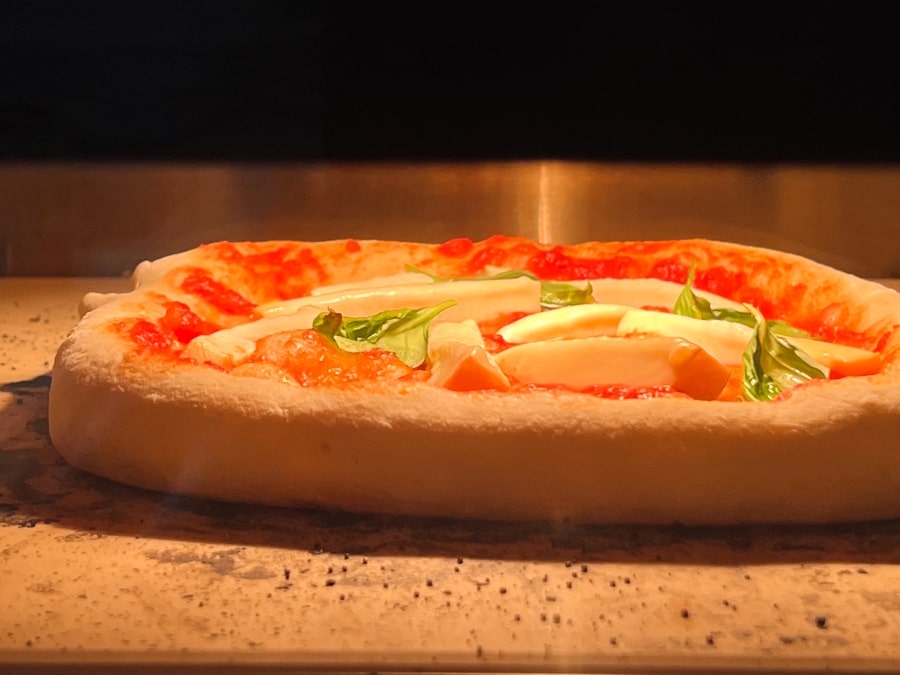
Using the Volt 12 is enjoyable. When you turn it on, it produces a happy sequence of beeps. The dials are nice and have good feedback — little beeps and gentle vibrations.
After you turn it on, just set a temperature and wait — no need to adjust a flame, add fuel, or monitor the fire. It beeps when it reaches whatever temperature you set it to. This ease of use allows you to focus on making pizza, which, as I discuss more below, is especially good if you’re new to cooking at high temperatures.
Compared to the Breville, the Volt 12 has a larger opening and cooking surface. Still, I was concerned that the opening wouldn’t be big enough to easily launch pizzas off a peel. I did need to adjust the angle that I launched pizzas at a bit compared to my home oven but, with a little practice, recipe customizations, and several steps to avoid sticking, launching pizzas has become easy. (I’ll post a video showing my first launch compared to a more recent one.) The stone inside the oven is 13 inches by 13 inches, making it suitable for pizzas 12 inches and smaller — plenty of space for a standard Neapolitan-style pizza.

I haven’t timed it yet but the oven seems to come back up to temperature very quickly (see below for an update where I did time the recovery time). By the time I’ve had a slice of the prior pizza, stretched and topped a new one, the Volt 12 is back to full temperature and able to produce another excellent pizza.
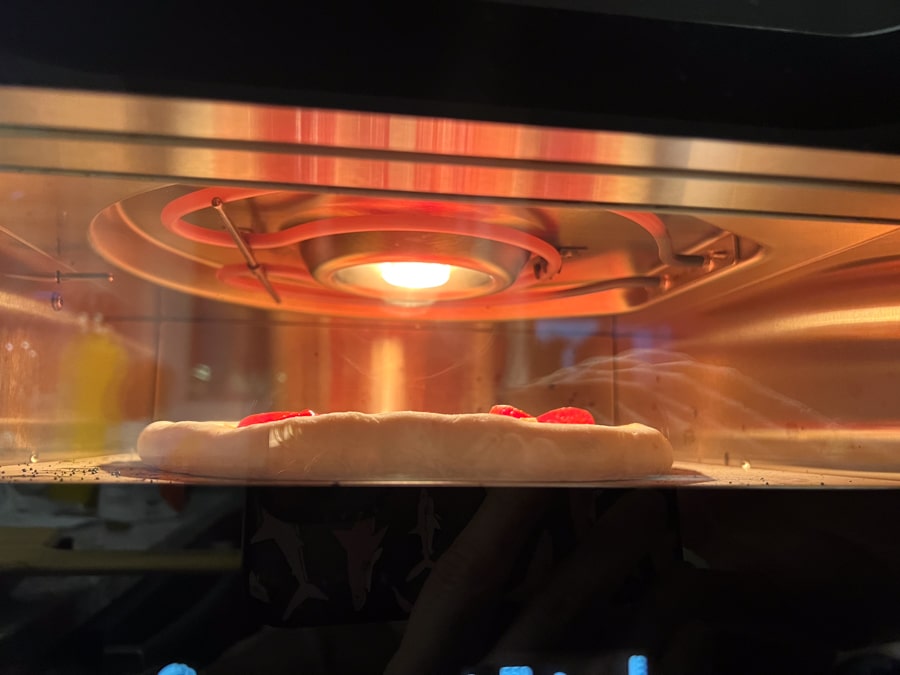
The glass door and interior light (no light in the Breville) were not something I considered important when I bought the oven. But, after using it a few times, I’ve found them extremely helpful. The oven cooks pizza very quickly and being able to see what’s happening inside makes it easier to know when to turn the pizza and when it’s ready to come out.
Cleaning the Volt 12
Ooni says to never put water on the stone. To clean it, they suggest flipping it over and letting whatever is on it burn off. Despite my initial skepticism, this method appears to work surprisingly well. After two bakes with the dirty side down, the stone looks nearly new again.
Of course, little burned bits do still get in the oven, especially near the door where you are sliding the pizzas on and off the peel. Since Ooni cautions so strongly against getting any water on the stone, I use a little handheld vacuum to hoover up the bits of char after the oven cools completely. So far flipping the stone and doing a little vacuuming has kept the oven clean.
Nothing Is Perfect
Of course, there are disadvantages to the Volt 12. If you use it indoors, then smoke becomes much more of an issue than it is for outdoor ovens. So, while tossing on some extra semolina on your peel to ensure a smooth transfer to the oven is no big deal with an outdoor oven, it is when you cook indoors and the extra semolina burns, setting off your smoke alarm and necessitating a quick opening of nearby windows. This is not an insurmountable obstacle of course: by topping the pizza before putting it on the peel, I was able to greatly reduce the amount of semolina needed and essentially eliminate smoke (more suggestions to reduce semolina and smoke below in the 7-month update). And, if you have an outdoor space, the Volt 12 is rated for outdoor use, making for another potential solution.
Ooni has suggestions and temperature settings for a wide range of pizzas, but I’m not sure why you would use this oven for anything besides those pizzas that require higher temperatures: Neapolitan, New York, and New Haven being the main ones that I can think of. (In my 7-month update, you’ll see testing indicates the Volt 12 really only outshines the home oven for Neapolitan-style pizza.) For other styles, I plan to stick with my home oven. I can’t fit my Detroit-style pan in the Volt and don’t see why I’d want to buy a smaller pan to cook a smaller pizza, when I get excellent results from my home oven.
High Heat Learning Curve

If you’re new to high-temp dedicated pizza ovens as I am, it will likely take some getting used to. I was shocked at how fast my first pizza cooked. In my home oven, I usually have a minute or two of leeway before the pizza goes from perfection to less than that. In the Ooni Volt 12, it’s a matter of seconds, not minutes.
In my first bake (image above), I couldn’t get the peel under the finished pizza and by the time I’d turned around and grabbed tongs, the back half of it had burned. At higher temperatures, every variation seems magnified — don’t stretch your dough thin enough and it won’t cook before the toppings burn; leave it in a few seconds too long and you’re pizza will look like my first attempt. The whole experience has given me increased respect for the Neapolitan pizza places I frequent.
Tips for Cooking With the Volt 12
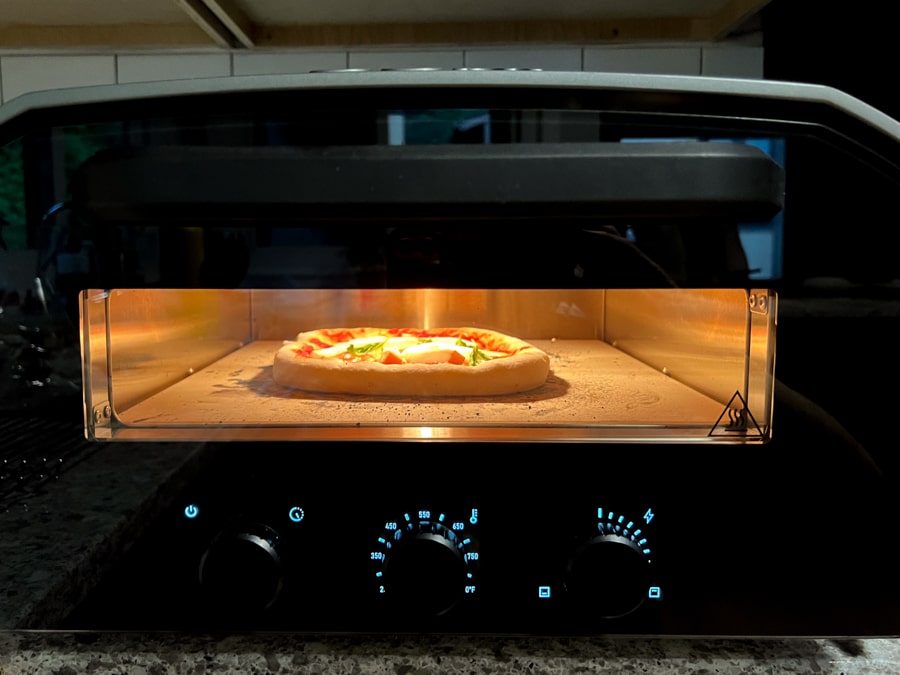
- After you plug it in, you have to hit a switch on the side. This turns on a power light on the front of the oven. You need to press this light to actually turn the oven on. The first time I used the oven, I thought the power light indicated the oven was on and ready to use. When I turned the dials and nothing happened, I briefly thought it was broken but quickly realized I just needed to touch the power light to turn the oven on.
- While it only takes about 15 minutes to reach maximum temperature, you’ll get better results if you wait at least 30 minutes to put the first pizza in (more details on this in the 7-month update).
- Stretching the pizza thinly produces better results. Not only does it ensure that the crust cooks through, but it also seems to create a nicer texture and lead to a better blend between sauce and crust. I try to make sure the crust is semi-translucent in places before I stop stretching.
- You do need to rotate your pizzas. I figured since the door of the oven closes, I wouldn’t need to rotate even though Ooni says to. Wrong. The back of the oven retains much more heat than the front, so rotating is essential. Ooni suggests once every 20 seconds, but I found that once per bake is sufficient. Eventually, I may purchase a turning peel, but, in the meantime, I find that a pair of metal tongs works, allowing you to keep the pizza in the oven as you rotate it. (Update: As you’ll see in the updated review, I was wrong on this as well — tongs work, but a turning peel is much better.)
That’s all for Now
That concludes my initial review. So far, I’m really enjoying cooking with the Ooni Volt 12 and feel like my pizzas are progressing rapidly. That said, I also know that I have yet to master the new oven and will need to keep practicing and experimenting. Once I do, I plan to write a more detailed and thorough review. I kept my word…a more detailed review starts now!
Seven-Month Update

I’ve had the Volt 12 for about 7 months now. I’ve made a lot of pizzas with it and am still loving it. Making pizza at high temperatures is just fun — you get to see the pizza change rapidly in front of you and the skills required for getting the pizza in, rotating it, and getting it out are a little challenging to learn but rewarding to use once acquired. Additional time with the oven has given me additional insights, which I share below.
The Volt 12 Is Best Used Outdoors
Ooni’s Volt 12 is marketed as an indoor oven that you can use outdoors. I’d say that because of the smoke it creates, you’ll have more flexibility with your dough and a more enjoyable experience if you can use it outdoors. Why would I opt for outdoors if possible? Some of the best pizzas I’ve made in the Volt 12 have a higher hydration — the doughs contain more water, making them wetter and stickier. However, higher hydration requires more semolina and flour to prevent sticking. (This is especially true with the Volt 12 because the narrow opening limits the angle you can put your peel at, making it a bit more challenging to slide your pizzas off the peel.) Semolina burns and produces a significant amount of smoke, not what you want when cooking indoors. However, after a lot of trial and error, reading, and observing, I’ve come up with several techniques and a recipe that produces excellent results when cooking with the Volt indoors. I list the techniques below.
Tips to Avoid Pizzas Sticking to the Peel
- Don’t make a dough with too high a hydration — yes, it may offer some improvement in the finished product, but, if you can’t get it off your peel without an excessive amount of semolina, you’re going to fill your house with smoke. I’ve found around 65% to be an optimal hydration. (See my recipe for an example of how to accomplish that.)
- When stretching the dough, begin by putting the dough ball in a small pile of flour. Flip it over to coat both sides and start stretching with your fingers while keeping the dough in the flour. Once you have it started, roll around the edges of the stretched dough to make sure they are also coated. Lift it up and shake it off. Move the dough to a clean area of the counter and continue stretching. Make sure that the side you pressed into the flour remains the bottom side — that extra flour the dough absorbed when you pressed it down will help prevent sticking.
- Top the pizza on your counter, then slide it to the peel. There’s a reason most pros you see top before putting their pizzas on the peel — the more time the pizza is on the peel the more time it has to adhere to it.
- Minimize the use of semolina on the peel. You’ll have to experiment with this to see how little semolina you can get away with. The less you use, the less smoke your pizza will produce.
- Turn on your kitchen fan when you start. Despite all the tips, you may still have some smoke so be prepared.
- Don’t overtop your pizza! I love toppings so this one took me a while to accept, but once I started reducing my toppings, my pizzas started improving and launching became easier. This goes for sauce, cheese, and anything else you put on the pizza, but I would say that reducing the sauce and cheese have the biggest impact.
Choosing a Recipe
When I received my Volt, I wanted to try it out right away, so I found Ooni’s “quick pizza dough” recipe and followed it closely. The dough tasted better than I thought it would, and I planned to make it again…that is until I waited an hour or so and the excessive amount of yeast the recipe uses began to expand in my stomach and make it feel like it would explode. After that, I opted to go with longer rising doughs that use less yeast — they taste better, are easier to work with, and are much easier on your digestive system. However, I couldn’t find one that worked well with the Volt 12, which has different considerations (discussed above and in the linked-to recipe) than wood and gas-fired Oonis, so I created my own recipe.
A Purpose Driven Oven for Neapolitan-Style Pizza
Ooni provides recipes and pans for a plethora of pizza types, but the Volt 12 is really an oven for making Neapolitan-style pizza. It hits the high temperatures that your kitchen oven can’t, allowing you to make markedly better Neapolitan-style pizza. I initially thought the Volt 12 would also produce superior New York style pizzas. However, in testing, I can’t tell a difference between New York style pizza cooked on a baking steel in my home oven and pizza cooked in the Ooni. I think the larger size (less heat loss when the pizza is added) and the conductivity of the steel cancel out the higher heat the Volt 12 produces. On the other hand, I definitely notice the difference between Neapolitan-style pizzas cooked in the Ooni versus my home oven. Only the Ooni’s come out as they should.
To sum up, the steel can overcome a difference of a hundred degrees or so, but not a difference of a few hundred degrees. So, if you want to make any type of pizza except Neapolitan style, get a steel (but don’t overpay) or cast iron skillet and use your regular oven. Regular ovens are larger and can consistently produce good results. You’ll also find it easier to launch your pizzas from the peel to your larger home oven. Plus, you can easily fit standard size pans (Detroit style, sheet pans, etc.) into home ovens: when it comes to pizza more is more! Of course, if you don’t have an oven in your kitchen the Ooni would really make a good investment and allow you to cook a wide-variety of pizzas.
Temperature Readings & The Need for an Infrared Thermometer
In my initial review, I recommended waiting 30 minutes before cooking your first pizza. Early on, I’d hoped to learn the rhythms of the oven’s heating cycles and perfect my timing, but experience has shown me that isn’t reasonably feasible. Instead, what you really need is an infrared thermometer to check the temperature of the stone right before inserting your pizza. That said, my readings with the thermometer indicate that I was pretty close — 30 minutes after you turn the oven on should be close to optimal for your first pizza. If you start right after the preheat timer goes off (15–20 minutes after turning it on), then the stone will still be too cool for best results.
I purchased this infrared thermometer and love it. As to the correct stone temperature you should aim for, Ooni says that the heat of the stone should match the ambient temperature of the oven. My experience has not quite aligned with this suggestion. First, I haven’t recorded a stone reading of 850° F (the ambient oven temperature that I most often use). Second, when the stone is at its hottest (anything above 820° F), the bottom of the pizza tends to cook too quickly, burning before the top finishes. So, instead of aiming for 850° F, I get my best results when the stone is around 800° F just before the pizza goes in. I still need to spend more time experimenting and figuring things out though. My suspicion is that electric ovens have slightly different requirements than wood and gas fired ones and that Ooni based their stone temp recommendation on prior experience with those fuel sources, not with the Volt 12’s electric heating elements.
Another lesson from the infrared thermometer: the stone’s temperature drops remarkably fast when you open the door. I’ve observed 10–20° F drops seconds after opening the door. So, keep this in mind when cooking. Opening the door will have a huge impact on the temperature of the stone. Unlike wood and gas fired ovens, where the fire generates intense heat, the Ooni Volt relies on insulating and the build up of heat from the less intense heat of the electric coils.
Finally, as another Volt 12 owner noted, cooking with an electric pizza oven adds another level of difficulty when it comes to cooking the top of the pizza. Unlike the bottom of the pizza, the top relies both the interior temperature of the oven and the direct heat from whatever is heating the oven — fire with gas and wood-fired ovens or coils with the Volt 12. With wood and gas ovens, you can directly control the intensity of the heat from the flame. However, the Volt’s coils turn on and off automatically, based on the ambient temperature of the oven. The top will cook faster when the coils are on, but, because of the stone, the bottom cooks more consistently, regardless of whether the coils are on or not. I’m not sure how best to address this yet but will update if I find a consistent method.
Volt 12 Temperature Readings
The infrared thermometer has also allowed me to take some temperature readings that I couldn’t in my early review. I list the readings below but want to make one comment first. I saw a video of someone putting their hand on top of the Ooni Volt 12 to demonstrate how cool it stayed when on. Don’t do this. The top gets hot! The longer the oven is on, the hotter the top gets and my temperatures below probably do not represent the highest temperatures the top will reach.
General Readings (Oven set to 850° F)
| After Preheat* | 10 Min. Later | After 1 Hour | |
| Exterior Top | 106 | 123 | 140 |
| Silver Exterior** | 104 | 123 | 155 |
| Glass on Door*** | 94 | 133 | 205 |
| Front of Stone | 727 | 783 | NA |
| Back of Stone | 718 | 798 | NA |
Sample Changes in Stone Temperature
| Before Adding | Immediately After Removing | 5 Min. Post-Removal | 10 Min. Post-Removal | |
| Front of Stone | 795° F | 701° F | 801° F | 806° F |
| Back of Stone | 809° F | 760° F | 806° F | 825° F |
The numbers in the above chart are just a sample and temperatures seem to vary significantly. I saw changes of 50 to over 100°F on the front of the stone from right before adding the pizza to right after taking it out. The back of the stone seems to change less with shifts staying closer to 50° F but occasionally going higher. As the chart indicates, the recovery time is usually around 5–10 minutes. If you go longer than that, you will want to be careful the stone isn’t too hot before adding your next pizza.
Concerning Condensation
One humid summer day, I started up the Volt 12 and began prepping. When I turned around to check on the it, water was dripping off from the sides of the door and onto the counter. (Someone on Reddit posted about a similar experience and took a photo.) I panicked — Ooni emphasizes not to put water in the oven — and shut it off. I examined the oven. Despite what it looked like, water was not emanating from the oven itself. Instead, it appeared that hot air meeting the still cool surface of the upper lip of the oven was condensing and dripping down the sides that surround the door.
I figured this was a one-off incident on a particularly humid day — something that under normal circumstances would not happen. Then, it happened again. The second time it occurred on a cold day with the humidity in my home at only 39% and the ambient air temperature 64° F. This time the condensation formed not only on the door but inside of the oven itself, way in the very back corners. I found this more concerning than the first incident because the moisture was clearly present inside the oven. This time, I didn’t panic and took several images, a few of which I post below.
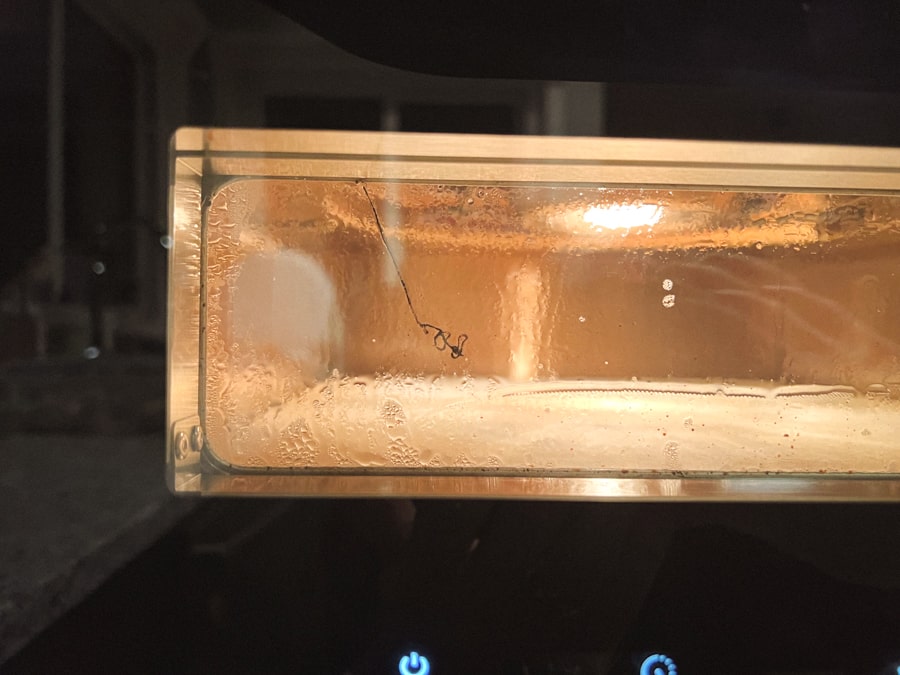
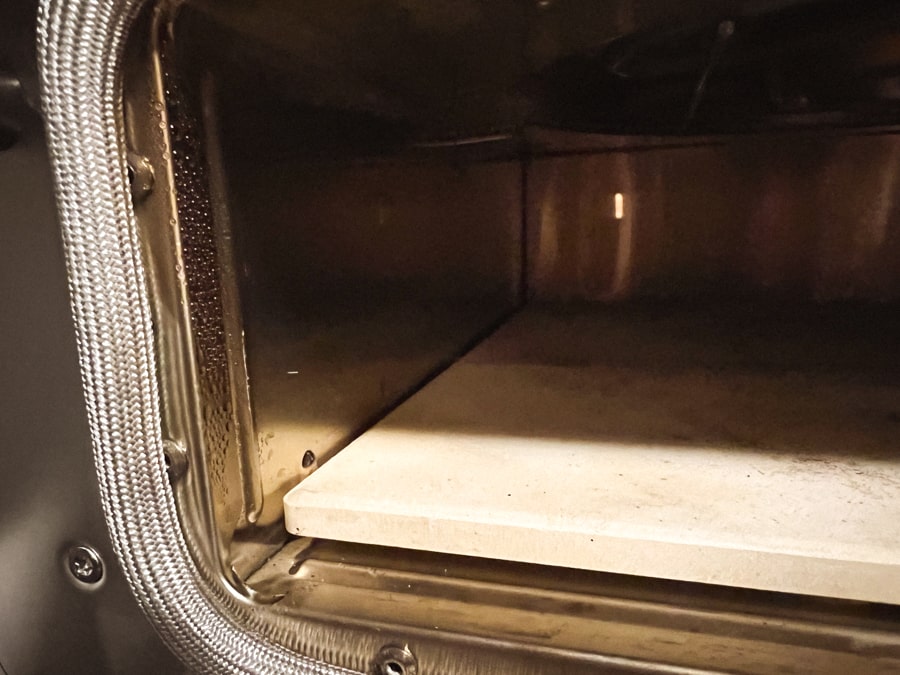
Ooni’s FAQs claim condensation is perfectly normal and nothing to worry about, but it still concerns me. Ooni suggests never cleaning the interior of the oven with liquids. Plus, electronic devices and moisture tend to be a bad combo. Also, I did not take my oven from indoors to outdoors as the FAQ suggests can cause condensation — my oven had been indoors the entire time on both occasions. Finally, the FAQ only discusses door condensation, and I observed condensation inside the oven itself.
Update: I emailed Ooni’s support team, included both of the above photos, and mentioned interior condensation. They said, “From the pictures you sent of the condensation inside your oven this looks totally normal. If you feel like the condensation is becoming excessive after your next few cooks and you are still worried please feel free to get some more photos and reach back out to us to double check. As for now, your oven looks good to carry on cooking!” They also noted that sometimes I’ll see condensation and other times I will not but did not elaborate on when to expect condensation.
My theory is that the issue is a combination of the cold surfaces of the Volt 12 and a lack of ventilation. In a wood fired or gas oven, chimneys allow for excellent ventilation, but, with an electric oven, Ooni may have needed to slow the airflow in order to hit the desired temperatures. Is there a solution? Not one that I am aware of, but I will experiment with trying to pre-warm my oven before pre-heating.
Get a Turning Peel
For a while, I used a pair of tongs to rotate the pizza and assist with removing it from the oven. Then I got a turning peel. I didn’t think the peel would make that much of a difference. I was wrong. Peels are power! You have much more flexibility and control over the pizza. You can minimize time the pizza isn’t in contact with the stone and rotate it without squishing part of the crust.
A replacement door?
I noticed that Ooni offers a replacement door for the Karu 16. I’m already noticing some discoloration on the door of my Volt 12 and am sure this will worsen over time. The option for a replacement door would be great! However, I imagine Ooni will have more issues creating a replacement door for the Volt 12 because they put the dials on the door, which means they also wired the door.
No Issues With the Stone
Before buying the Volt, I seriously considered the Breville Pizzaiolo. But, in addition to it only hitting 750° F, all the reports of broken stones held me back. I wondered if the Volt 12 would have a similar problem. So far my stone has not had any issues, so it would appear Ooni has come up with a somewhat better stone solution than Breville…time will tell though.
Why I’d Still Choose the Volt 12
I’ve laid out several concerns above, but I’d still choose the Volt 12 if I were in the market for a home pizza oven to make Neapolitan-style pizza in. Why? The ease and versatility can’t be beat. The Volt 12 is the only widely available home pizza oven that hits the temps needed for Neapolitan-style pizza and can be used both indoors and outdoors. (Effeuno does offer a line of electric ovens that get hotter than the Ooni, but they are not rated for outdoor use and, as I mentioned above, not designed for the common voltage used in the U.S.) Using the Volt 12 requires minimal effort, and it’s easy to control — you don’t need to purchase propane or wood or charcoal, just plug it in and you’re ready to start making pizza. You’ll find the ease of use especially helpful if you haven’t made Neapolitan-style pizzas before. Trust me, there are plenty of skills and challenges without adding in the need to adjust a flame or tend to a wood fire. Plus, even if you have an outdoor space, there will probably be times when you don’t want to cook outdoors — like when it’s raining, windy, too hot, or too cold. On those days, the Volt 12 give you the option to move indoors, something non-electric ovens don’t offer. And, most importantly, the Volt 12 produces excellent results. I’m making the best Neapolitan-style pizzas I’ve ever made and truly enjoying the process.

